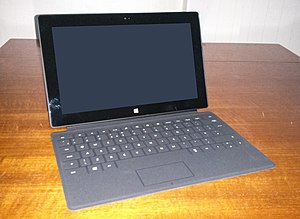Surface (first generation)
 |
|
 |
|
| Developer | Microsoft |
|---|---|
| Product family | Microsoft Surface |
| Type | Hybrid tablet |
| Release date | October 26, 2012 |
| Discontinued | July 18, 2013 |
| Operating system | Windows RT |
| System-on-chip used | Nvidia Tegra 3 |
| Memory | 2 GB |
| Storage | 32/64 GB microSDXC card slot |
| Sound | Stereo speakers |
| Input | Two 720p HD LifeCams, front and rear facing Two Microphones, headset jack, Ambient Light Accelerometers Gyroscope Compass |
| Connectivity |
Wi-Fi (802.11 a/b/g/n) Bluetooth 4.0 USB 2.0 HD video out (micro-HDMI) |
| Power | Built-in rechargable Li-Po 31.5 Wh 24 W power supply |
| Online services | Windows Store, OneDrive, Outlook.com, Microsoft Account, Xbox Music, Xbox Live |
| Dimensions | 10.81 by 6.77 by 0.37 inches (27.46 cm × 17.20 cm × 0.94 cm) 1.5 pounds (680 g) |
| Weight | 1.5 lbs |
| Successor | Surface 2 |
The first-generation Surface (launched as Surface with Windows RT, later marketed as Surface RT) is a hybrid tablet computer, that was developed and manufactured by Microsoft. Announced on June 18, 2012, it was released on October 26, 2012, and was the first ever personal computer designed in-house by Microsoft.
Positioned as a direct competitor to Apple's iPad line, Surface included several notable features, including a folding kickstand, which allows the tablet to stand at some angles, and the ability to attach optional protective covers that incorporate keyboards. Surface served as the launch device for Windows RT, a variation of Windows 8 that was designed for devices based on ARM architecture. Windows RT contains notable differences and limitations compared to Windows 8, including several removed features, being bundled with a special edition of Microsoft Office 2013 Home & Student, and, besides software included with the operating system, being incompatible with desktop software that runs on Windows 8 for personal computers and tablets with Intel compatible processors. Windows RT can only run Metro-style apps obtained from Windows Store. However visually resembling Surface Pro 2-in-1 detachable, Surface is not considered a 2-in-1 PC, being in fact a variant of a hybrid tablet.
Surface was met with mixed reviews. Although praised for its hardware design, accessories, and aspects of its operating system, criticism was directed towards the performance of the device, as well as the limitations of the Windows RT operating system and its application ecosystem. Sales of the Surface were poor, with Microsoft cutting its price worldwide and taking a US$990 million loss in July 2013 as a result. It was succeeded by the Surface 2 in 2013, which comes with the newer RT 8.1 OS. The original Surface has also since received this update, and support for it and the Surface 2 will end in 2023.
...
Wikipedia
